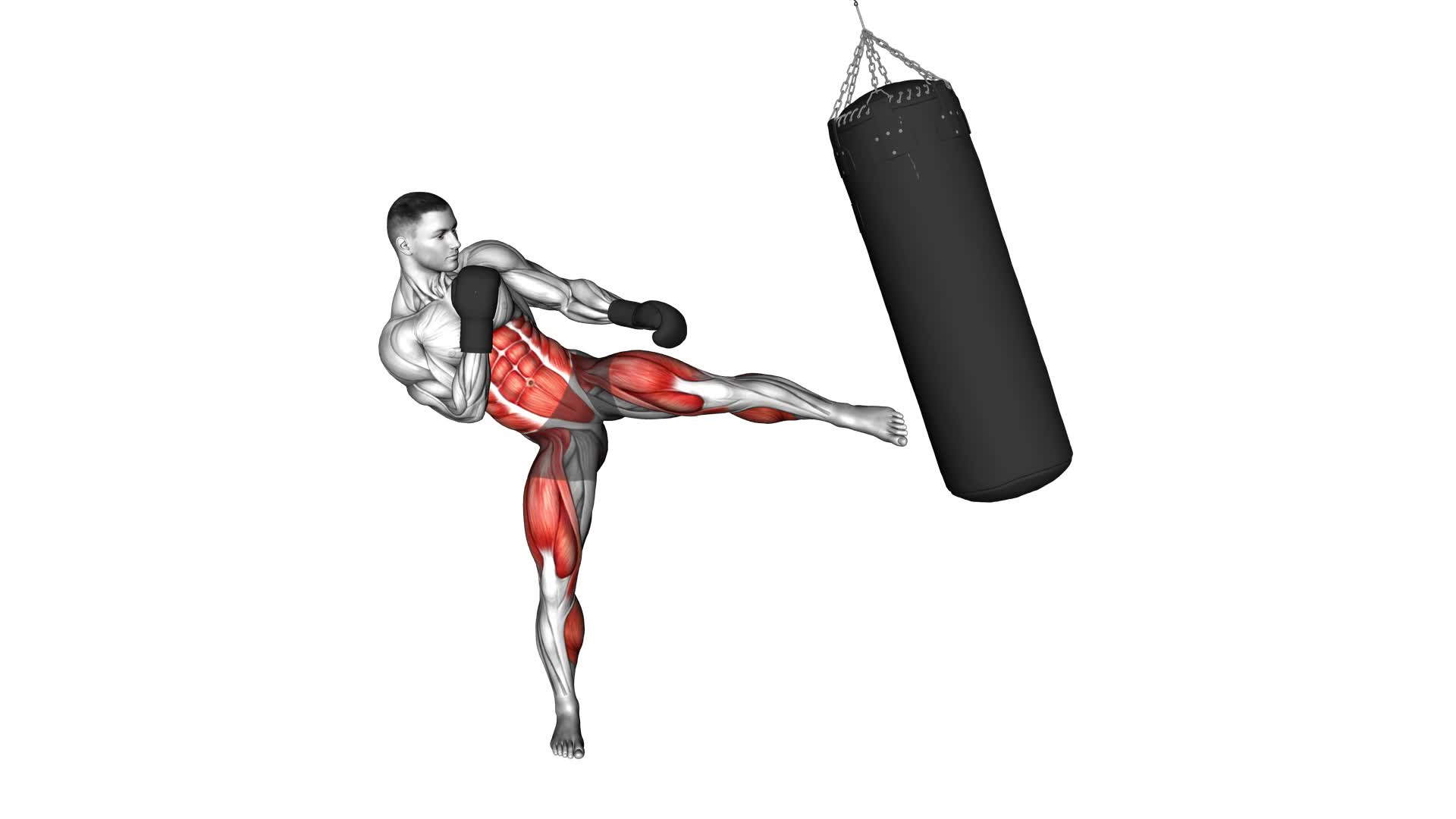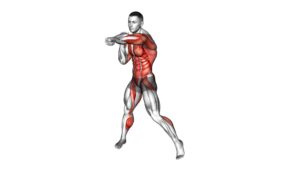Hook Kick Kickboxing (With Boxing Bag) – Video Exercise Guide & Tips

Are you ready to take your kickboxing skills to the next level?
Watch This Exercise Video
In this video exercise guide, you'll learn all about the hook kick, a powerful technique that will elevate your performance.
With proper technique and advanced training tips, you'll maximize the impact of your hook kicks.
Get ready to warm up, watch instructional videos, and discover effective combinations that will leave you feeling strong and empowered.
Let's dive in and unleash your inner kickboxing champion!
Key Takeaways
- Hook kicks in kickboxing are a versatile technique with various variations and target different areas of the opponent's body.
- Proper technique for hook kicks involves maintaining good balance, pivoting and rotating the hips for power, and avoiding over-rotating the hips while keeping the guard up.
- Essential warm-up exercises for hook kick kickboxing include dynamic stretching to warm up muscles, agility drills to enhance speed and coordination, and cardiovascular exercise to raise heart rate.
- Advanced training tips for maximum impact in hook kick kickboxing include focusing on power and speed, practicing advanced combinations for timing and accuracy, prioritizing injury prevention, and listening to the body and taking rest days when needed.
Benefits of Hook Kick Kickboxing
To fully understand the benefits of hook kick kickboxing, it's important that you incorporate this powerful move into your training routine. The hook kick is a versatile technique that offers various variations to keep your training engaging and effective. By mastering different hook kick variations, you can target different areas of your opponent's body, making it a valuable weapon in your arsenal.
One of the key benefits of incorporating hook kick kickboxing into your training is the improvement in your overall conditioning. The explosive nature of the hook kick requires you to engage your core, hips, and legs, leading to increased strength and power. By practicing conditioning exercises specifically designed for the hook kick, such as shadowboxing with a focus on executing the technique with precision and speed, you can enhance your cardiovascular endurance and muscular stamina.
Additionally, the hook kick kickboxing can improve your flexibility and agility. The dynamic movements involved in executing the hook kick require a good range of motion in your hips and legs. Regular practice of the hook kick can help increase your flexibility, allowing you to execute the technique with fluidity and precision. Furthermore, the quick pivoting and turning movements involved in the hook kick can enhance your agility, making you more adept at evading your opponent's strikes and quickly changing directions during a fight.
Proper Technique for Hook Kicks
When executing hook kicks in kickboxing, it's crucial to maintain proper technique for optimal effectiveness and power. To ensure you're performing hook kicks correctly, there are a few key points to keep in mind.
Firstly, maintain good balance by keeping your standing leg slightly bent and your core engaged. This will help you generate power and maintain stability throughout the movement.
Secondly, pivot on your supporting leg and rotate your hips as you swing your kicking leg in a circular motion. This rotation will give your hook kick its characteristic trajectory and power.
Common mistakes to avoid when performing hook kicks include over-rotating your hips, which can lead to loss of balance and reduced power. Additionally, be mindful of keeping your guard up to protect yourself while executing the kick.
It's important to note that there are variations and modifications to the hook kick that can be implemented based on individual preferences and training goals. For instance, some fighters may choose to use a more vertical trajectory for their hook kick, while others may prefer a more horizontal swing. These variations can add diversity and surprise to your attacks, keeping your opponents on their toes.
Essential Warm-Up Exercises
Start your kickboxing workout with these essential warm-up exercises to prepare your body for optimal performance and prevent injuries. Proper warm-up exercises are crucial to increase blood flow, improve flexibility, and enhance your overall agility.
Here are three essential warm-up exercises to incorporate into your kickboxing routine:
- Dynamic Stretching: Begin with dynamic stretching exercises to warm up your muscles and increase their range of motion. Perform exercises like leg swings, arm circles, and torso twists to loosen up your joints and improve flexibility. Dynamic stretching helps to activate your muscles and prepare them for the intense movements involved in kickboxing.
- Agility Drills: Next, incorporate agility drills into your warm-up routine. These drills focus on improving your speed, coordination, and reaction time. Include exercises like ladder drills, cone drills, and shuttle runs to enhance your footwork and agility. Agility drills help to sharpen your reflexes and prepare your body for the quick movements required in kickboxing.
- Cardiovascular Exercise: Finally, engage in a few minutes of cardiovascular exercise to raise your heart rate and warm up your body. This can include activities like jumping jacks, high knees, or jogging in place. By increasing your heart rate, you promote blood flow to your muscles, preparing them for the intense workout ahead.
Remember, a proper warm-up is essential to prevent injuries and maximize your performance in kickboxing. Incorporate these dynamic stretching exercises, agility drills, and cardiovascular exercises into your routine to ensure that your body is ready to go.
Get ready to kick and punch your way to a great workout!
Advanced Training Tips for Maximum Impact
Continue enhancing your kickboxing skills and achieving maximum impact with these advanced training tips. To take your training to the next level, it's crucial to incorporate advanced training techniques that will challenge your body and improve your techniques.
One effective technique is to focus on power and speed. By incorporating explosive movements, such as plyometric exercises and high-intensity interval training, you can develop greater power in your kicks and punches. Additionally, practicing advanced combinations can help you improve your timing and accuracy, making your strikes more effective in the ring.
Another important aspect to consider is injury prevention. As you progress in your training, the risk of injuries increases. To minimize the chances of getting injured, it's essential to focus on proper form and technique. Make sure to warm up adequately before each training session and stretch properly afterwards. Additionally, incorporating strength and conditioning exercises into your routine can help strengthen your muscles and joints, reducing the risk of injuries.
As you continue your training journey, remember to always listen to your body and take rest days when needed. Push yourself, but also know your limits. By following these advanced training techniques and injury prevention strategies, you can maximize your impact and take your kickboxing skills to new heights.
Now, let's move on to the next section and explore effective combinations with hook kicks.
Effective Combinations With Hook Kicks
To maximize the effectiveness of your hook kicks, focus on incorporating effective combinations that capitalize on the power and precision of this striking technique. By adding other techniques and movements into your hook kick combinations, you can create a more dynamic and unpredictable attack.
Here are three effective combinations to enhance your hook kicks:
- Hook Kick Followed by a Straight Punch:
Throw a hook kick to the opponent's head or body, and immediately follow it up with a straight punch to their face or chest. This combination works well because the hook kick can create an opening, leaving your opponent vulnerable to the straight punch.
- Hook Kick into a Roundhouse Kick:
After landing a hook kick, quickly transition into a roundhouse kick. This combination is effective because the hook kick can catch your opponent off guard, and the roundhouse kick delivers a powerful strike from a different angle.
- Hook Kick followed by a Spinning Back Fist:
Execute a hook kick, and as you bring your leg back, spin your body and throw a back fist strike. This combination is unexpected and can catch your opponent off balance, increasing the chances of landing a powerful blow.
To defend against hook kicks, it's crucial to be aware of counter techniques. Some effective counter techniques for hook kicks include stepping back to avoid the kick, blocking or parrying the kick, or countering with a well-timed punch or kick to the opponent's exposed side.
Frequently Asked Questions
What Are the Common Mistakes to Avoid While Performing Hook Kicks in Kickboxing?
When performing hook kicks in kickboxing, it's important to be aware of common mistakes that can hinder your technique.
To effectively use hook kicks in self-defense situations, avoid these errors.
First, don't overextend your leg, as this can compromise your balance.
Second, keep your hips and shoulders aligned to generate maximum power.
Lastly, remember to maintain proper foot position and aim for the target with precision.
How Can I Improve My Flexibility to Execute Hook Kicks Properly?
To improve your flexibility for executing hook kicks properly, it's important to focus on stretching exercises that target your hip flexors, hamstrings, and hip rotators. These stretches will help increase your range of motion and allow you to kick higher and with more power.
Additionally, practicing proper technique, such as keeping your standing leg strong and pivoting on the ball of your foot, will ensure that your hook kicks are executed correctly.
Keep pushing yourself and you'll see progress in no time!
Are There Any Specific Safety Precautions to Take While Practicing Hook Kicks With a Boxing Bag?
When practicing hook kicks with a boxing bag, it's crucial to take safety precautions. Common injuries associated with hook kicks include strains, sprains, and even fractures.
To protect your hands, make sure to properly wrap them before starting. This will provide added support and reduce the risk of injury.
Can Hook Kicks Be Used Effectively in Self-Defense Situations, or Are They Mainly for Sport?
Hook kicks can definitely be used effectively in self-defense situations. They aren't just for sport. The power generated by the hook kick, combined with its unpredictable angle, makes it a practical and effective strike.
The biomechanics behind the hook kick involve rotating the hips and pivoting on the supporting foot, generating maximum force. So, if you find yourself in a self-defense scenario, don't underestimate the effectiveness of a well-executed hook kick.
Are There Any Alternative Exercises or Variations to Hook Kicks That Can Be Incorporated Into Kickboxing Training?
Looking for alternative exercises or variations to incorporate into your kickboxing training? Well, you're in luck! There are plenty of options when it comes to working on your hook kicks.
Martial arts offer various variations of hook kicks that you can explore and practice. These alternative exercises won't only add variety to your training but also help improve your overall technique and skill in kickboxing.
Conclusion
In conclusion, incorporating hook kicks into your kickboxing routine can bring numerous benefits. This includes improved flexibility, power, and overall technique. By mastering the proper technique and practicing essential warm-up exercises, you can enhance your performance and maximize the impact of your kicks.
Remember, combining hook kicks with other effective techniques can make your kickboxing routine even more dynamic and challenging. So, keep pushing yourself and strive for excellence in your kickboxing journey.

Author
Years ago, the spark of my life’s passion ignited in my mind the moment I stepped into the local gym for the first time. The inaugural bead of perspiration, the initial endeavor, the very first surge of endorphins, and a sense of pride that washed over me post-workout marked the beginning of my deep-seated interest in strength sports, fitness, and sports nutrition. This very curiosity blossomed rapidly into a profound fascination, propelling me to earn a Master’s degree in Physical Education from the Academy of Physical Education in Krakow, followed by a Sports Manager diploma from the Jagiellonian University. My journey of growth led me to gain more specialized qualifications, such as being a certified personal trainer with a focus on sports dietetics, a lifeguard, and an instructor for wellness and corrective gymnastics. Theoretical knowledge paired seamlessly with practical experience, reinforcing my belief that the transformation of individuals under my guidance was also a reflection of my personal growth. This belief holds true even today. Each day, I strive to push the boundaries and explore new realms. These realms gently elevate me to greater heights. The unique combination of passion for my field and the continuous quest for growth fuels my drive to break new ground.







